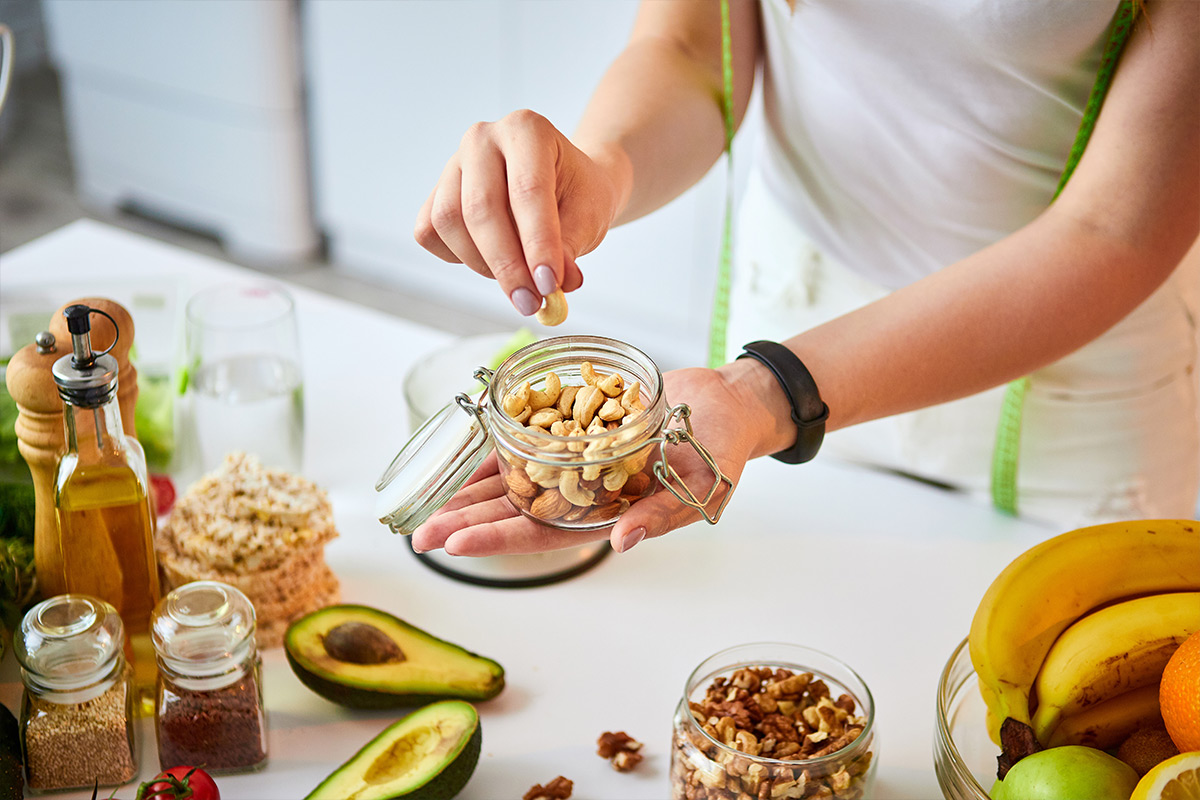Incorporating healthy carbohydrates into your diet can feel challenging, especially when cooking daily isn’t an option. Whether someone else does the cooking, you’re constantly on the go, or time simply isn’t on your side, there are still practical ways to ensure you get the nutrients your body needs. Even if you’re not in control of the kitchen, here are simple strategies to help you stay on track with eating healthy carbs.
Healthy Eating at Home
If someone else in your household handles most of the cooking or meal planning, open communication is essential. Start by expressing gratitude—whether it’s a family member, roommate, or friend. Acknowledging their effort fosters a positive connection and strengthens relationships, which research shows can increase life satisfaction (1). A little appreciation can go a long way and set the stage for constructive conversations about your health goals.
When you’re ready to discuss incorporating healthier carbohydrates into meals, timing is everything. Avoid bringing it up right after they’ve prepared a meal—this can come across as inconsiderate or ungrateful. Instead, choose a moment when they’re relaxed and share how adding healthy carbs like whole grains (brown rice, quinoa, or whole wheat pasta), legumes, and vegetables can help you feel better and manage your blood sugar more effectively.
It’s important to recognize that the cook may not be as ready for lifestyle changes as you are. Respect their perspective and schedule while offering ways to make it a team effort. For example, you can:
- Share helpful resources from LIVE TULA, like recipes, webinars, or advice from your HealthCoach.
- Offer support with meal planning, brainstorming new recipes, or adding items to the grocery list.
- Join them in the kitchen to help prep meals or try cooking something new together.
By approaching the conversation with gratitude, flexibility, and a spirit of teamwork, you can strengthen your relationship while working toward your health goals. The kitchen can become a place for collaboration, connection, and positive change!
Healthy Eating on the Road
Whether you’re traveling for work or pleasure, maintaining balanced nutrition can feel challenging. However, with a little planning and intention, you can still make healthy choices while allowing room for flexibility. Remember, disruptions to your routine are expected, and that’s okay. Use this as an opportunity to reflect on why you’re prioritizing your health and celebrate small wins—like being mindful of your food choices!
Smart Snacking on the Go
Pack non-perishable, nutrient-dense snacks that are easy to grab, such as:
- Fresh fruit (apples, bananas, oranges)
- Nuts, seeds, and nut butter packs
- Whole-grain crackers or popcorn
- Granola bars
These options provide healthy fats, fiber, and protein to keep you full longer. To avoid last-minute decisions, plan your breakfast the night before. For example:
- Skip the donut and opt for a whole-grain English muffin.
- Swap waffles with syrup for oatmeal and a banana.
Pro Tip: Use the continental breakfast to your advantage! Grab an extra piece of fruit for a snack later in the day.
Navigating Restaurants and Dining Out
Eating out can be fun but tricky when making healthier choices. Here are some simple strategies:
- Start with Vegetables: Begin with a veggie-based appetizer, a broth-based soup, or a green salad. Research shows that starting with vegetables helps manage post-meal blood sugar levels (3, 4).
- Choose Whole-Grain Options: When offered a choice of sides, opt for whole grains like brown rice, quinoa, buckwheat, or millet. Don’t hesitate to ask, “Is this a whole-grain option?”—restaurants are often happy to clarify.
- Be Smart with Sides:
- Prioritize sides that are baked, boiled, or steamed.
- Avoid fried or creamy options, which tend to be higher in saturated fats that can disrupt blood sugar control.
- If available, choose vegetable-based sauces over cream-based ones.
- Ask for Modifications: It’s OK to customize your order! Small changes can have a big impact:
- Swap fries for a side salad or steamed veggies.
- Ask for dressings and sauces on the side.
- Request whole-grain bread or brown rice as substitutes.
By planning ahead and making simple, intentional choices, you can enjoy your travels while staying on track with your health goals. Remember, progress—not perfection—is the key!
Time-Saving Strategies for Healthy Eating
When life gets hectic and cooking every day feels impossible, a little preparation can go a long way in maintaining a balanced diet. Here are some practical tips to help you stay on track:
Batch Cooking: Your Nutrition Lifesaver
Prepare large portions of healthy meals on your less busy days and store them for the week ahead. Great carbohydrate options for batch cooking include:
- Brown rice
- Quinoa
- Lentils
- Beans
- Plant-based protein pasta
Pro Tip: Cook two different carbohydrate sources, divide them into portions, and freeze half for balanced, ready-to-reheat meals. Aim for about one cup (or a fist-sized portion) of whole grains per serving.
Bonus Benefit: Batch-cooked and cooled starchy carbs develop resistant starch, which has unique health perks. Resistant starch resists digestion in the small intestine and ferments in the large intestine, offering benefits such as improved blood sugar control, reduced appetite, and enhanced gut health—even after reheating (5)
Try Sheet-Pan Meals
For a quicker, stress-free cooking option, sheet-pan recipes are your best friend. Toss all ingredients on one pan, bake, and you’re done—with minimal cleanup. Save even more time by using pre-chopped vegetables.
Family Favorite Idea:
- Ingredients: Cauliflower florets, taco seasoning, tofu, bell peppers, and red onions.
- Instructions: Roast everything, then serve in bowls or tortillas with black beans, pico de gallo, and avocado.
Sheet-pan meals are ideal for making a delicious, balanced dinner in under 30 minutes.
Smart Solutions When Time Is Tight
If batch cooking or sheet-pan meals aren’t feasible, here are alternatives:
- Meal Prep from Restaurants: Many restaurants offer healthier “meal prep” dishes. Opt for baked, grilled, steamed, or roasted proteins, whole grains, and extra vegetables.
- Build-Your-Own Meals: Some places let you customize dishes with your choice of veggies, lean proteins (like beans or lentils), and healthy fats (like olives or avocado). Order a couple of meals to take home for the next 2–3 days.
Even during your busiest times, these strategies can keep you on track with healthier carbohydrate choices and overall nutrition goals.
Healthy Carb Choices: Fueling Your Brain and Body
Carbohydrates are your brain’s primary energy source, making them an essential part of a balanced diet. But not all carbs are created equal. The key lies in choosing carbs that support your blood sugar and overall health. Here’s how to make carbs work for you:
- Choose Wisely: Opt for whole, unprocessed carbohydrates like whole grains, legumes, and vegetables, which provide steady energy without spiking your blood sugar.
- Plan Ahead: Whether it’s meal prepping, scoping out restaurant menus, or keeping a stash of healthy snacks, a little planning ensures you have healthy options at your fingertips.
- Be Mindful: Stay aware of portion sizes and preparation methods, as these can significantly impact the nutritional value of your meals.
By making intentional, informed choices, you can keep healthy carbohydrates in your diet, no matter your schedule or circumstances.
Sending Health Your Way!
The Tula Clinical Team
Austin MS, RDN, CSR, LDN, CD
Aubree RN, BSN
Tula Takeaways |
|---|
| 1. Relationships Matter: Adopting new dietary habits doesn’t mean giving up social connections. Attend dinners or nights out, but plan ahead by choosing healthier menu options. Shift your focus to enjoying the company and atmosphere, making the experience more meaningful than the food choices. |
| 2. Call Your Tula HealthCoach: When challenges arise, talking to someone who listens and understands can be invaluable. Your HealthCoach is there to support you, offering personalized strategies to overcome obstacles and stay on track with your health goals. |
| 3. What Makes a Carb Healthy? Learn to distinguish healthy carbs from highly processed ones. Check for fiber content and consider how the food was processed. For example, boiled whole grains are healthier than grains that have been extensively refined and manipulated into forms like dough or pasta. The fewer steps from nature to your plate, the better. |
| 4. Power of Produce: Incorporate fruits and starchy vegetables into your meals by pairing them with healthy fats or lean proteins. This combination provides balanced nutrition and helps stabilize blood sugar levels. |
The LIVE TULA blog is informational and not medical advice. Always consult your doctor for health concerns. LIVE TULA doesn’t endorse specific tests, products, or procedures. Use the information at your own risk and check the last update date. Consult your healthcare provider for personalized advice.






